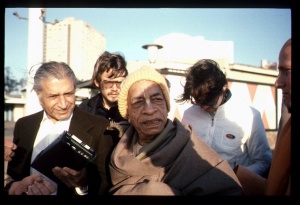CC Madhya 20.135 (1975)

A.C. Bhaktivedanta Swami Prabhupada
TEXT 135
- pūrva-dike tāte māṭī alpa khudite
- dhanera jhāri paḍibeka tomāra hātete
SYNONYMS
pūrva-dike—on the eastern side; tāte—there; māṭī—the dirt; alpa—small quantity; khudite—digging; dhanera—of the treasure; jhāri—the pot; paḍibeka—you will get; tomāra—your; hātete—in the hands.
TRANSLATION
" 'However, if you dig up a small quantity of dirt on the eastern side, your hands will immediately touch the pot of treasure.'
PURPORT
The Vedic literatures, including the Purāṇas, state that according to the position of the conditioned soul, there are different processes-karma-kāṇḍa, jñāna-kāṇḍa, the yogic process and the bhakti-yoga process. Karma-kāṇḍa is compared to wasps and drones that will simply bite if one takes shelter of them. jñāna-kāṇḍa, the speculative process, is simply like a ghost who creates mental disturbances. Yoga, the mystic process, is compared to a black snake that devours people by the impersonal cultivation of kaivalya. However, if one takes to bhakti-yoga, he becomes quickly successful. In other words, through bhakti-yoga, one's hands touch the hidden treasure without difficulty.
Therefore it is said in Bhagavad-gītā: vedaiś ca sarvair aham eva vedyaḥ. One has to take to devotional service. Although the Vedas enjoin one to search out Kṛṣṇa and take shelter at His lotus feet, other Vedic processes will not help. According to Bhagavad-gītā, only the bhakti process is said to be definitive. Bhaktyā mām abhijānāti. This is the conclusive statement of the Vedas, and one has to accept this process if one is serious in searching for Kṛṣṇa, the Supreme Personality of Godhead. In this connection, Śrīla Bhaktisiddhānta Sarasvatī Ṭhākura gives the following statement. The eastern side represents devotional service to Lord Kṛṣṇa. The southern side represents the process of fruitive activity (karma-kāṇḍa), which ends in material gain. The western side represents jñāna-kāṇḍa, the process of mental speculation, sometimes called siddhi-kāṇḍa. The northern side represents the speculative method sometimes known as the mystic yoga system. It is only the eastern side, devotional service, that enables one to attain life's real goal. On the southern side, there are fruitive activities by which one is subject to the punishment of Yamarāja. When one follows the system of fruitive activity, his material desires remain prominent. Consequently the results of this process are compared to wasps and drones. The living entity is bitten by the wasps and drones of fruitive activity and thus suffers in material existence birth after birth. One cannot be free from material desires by following this process. The propensity for material enjoyment never ends. Therefore the cycle of birth and death continues, and the spirit soul suffers perpetually.
The mystic yoga process is compared to a black snake that devours the living entity and injects him with poison. The ultimate goal of the yoga system is to become one with the Absolute. This means finishing one's personal existence. However, the spiritual part and parcel of the Supreme Personality of Godhead has an eternal individual existence. Bhagavad-gītā confirms that the individual soul existed in the past, is existing in the present and will continue to exist as an individual in the future. Artificially trying to become one with the Absolute is suicidal. One cannot annihilate his natural condition.
A yakṣa, a protector of riches, will not allow anyone to take away riches for enjoyment. Such a demon will simply create disturbances. In other words, a devotee will not depend on his material resources but on the mercy of the Supreme Personality of Godhead, who can give real protection. This is called rakṣiṣyatīti viśvāsaḥ or (in the Bengali poetry of Bhaktivinoda Ṭhākura's Śaraṇāgati), 'avaśya rakṣibe kṛṣṇa'-viśvāsa pālana. The surrendered soul must accept the fact that his real protector is Kṛṣṇa, not his material acquisitions.
Considering all these points, devotional service to Kṛṣṇa is the real treasure house for the living entity. When one comes to the platform of devotional service, he always remains opulent in the association of the Supreme Personality of Godhead. One who is bereft of devotional service is swallowed by the black snake of the yoga system and bitten by the wasps and drones of fruitive activity, and he suffers consequent material miseries. Sometimes the living entity is misled into trying to merge into spiritual existence, thinking himself as good as the Supreme Personality of Godhead. This means that when he comes to the spiritual platform, he will be disturbed and will again return to the material platform. According to Śrīmad-Bhāgavatam (10.2.32):
- ye 'nye 'ravindākṣa vimukta-māninas
- tvayy asta-bhāvād aviśuddha-buddhayaḥ
- āruhya kṛcchreṇa paraṁ padaṁ tataḥ
- patanty adho 'nādṛta-yuṣmad-aṅghrayaḥ
Such people may become sannyāsīs, but unless they take shelter of Kṛṣṇa's lotus feet, they will return to the material platform to perform philanthropic activities. In this way, one's spiritual life is lost. This is to be understood as being devoured by the black snake.